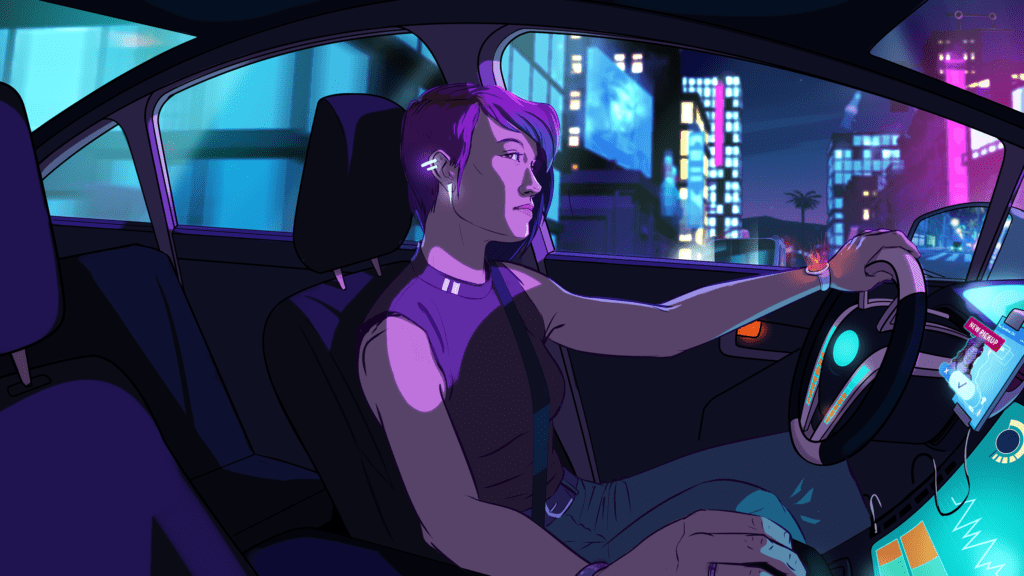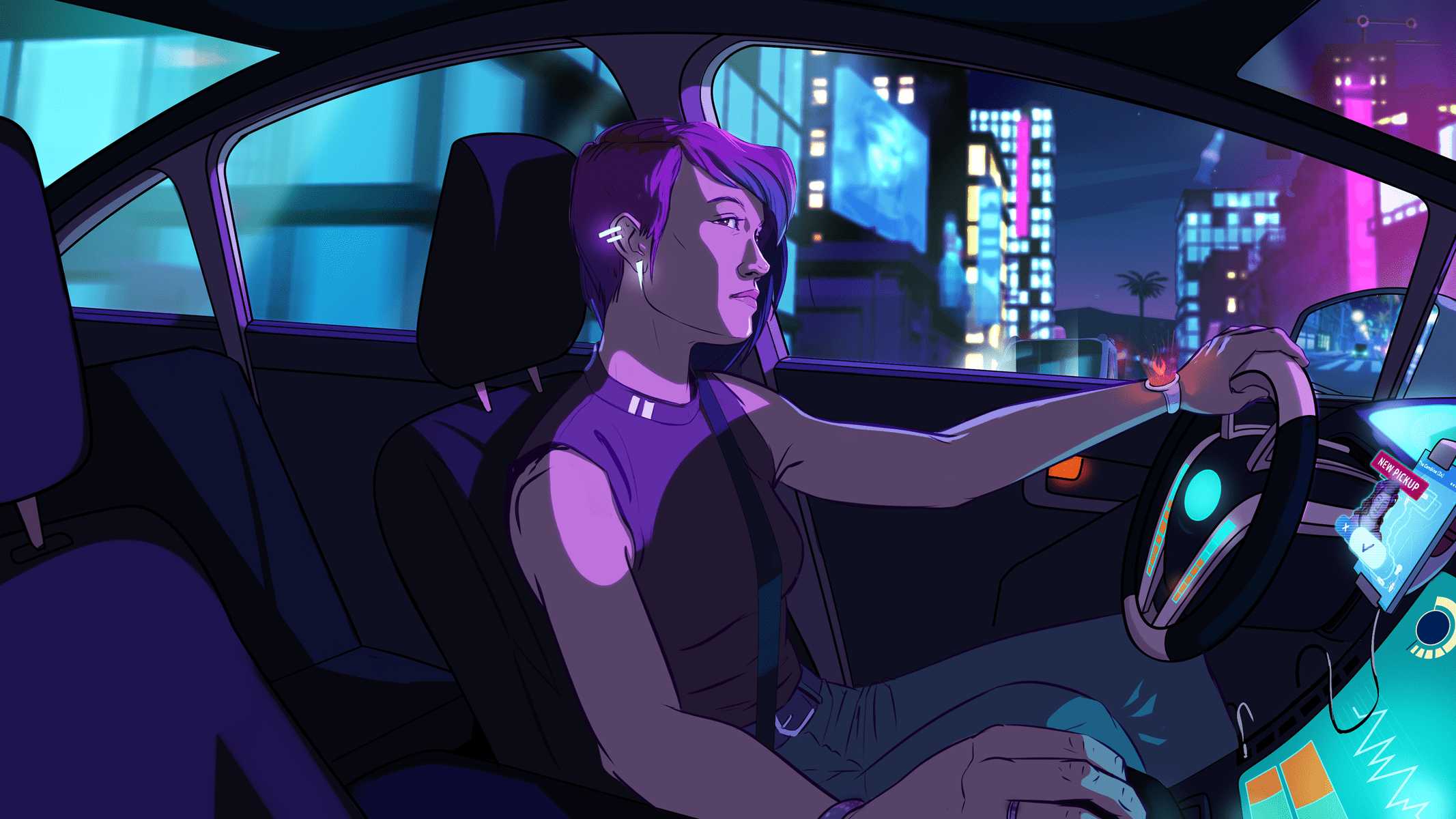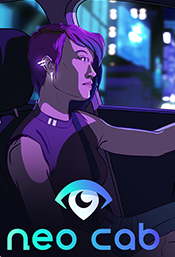You can trust VideoGamer. Our team of gaming experts spend hours testing and reviewing the latest games, to ensure you're reading the most comprehensive guide possible. Rest assured, all imagery and advice is unique and original. Check out how we test and review games here
Lina is driving to Automation City in Los Ojos, California. She’s going to move in with her best friend, Savy, and although the two of them haven’t connected in a while, she’s thrilled to finally escape her lacklustre hometown. Well, mostly thrilled. Lina is one of the last human drivers working for the taxi company Neo Cab, one of two tech giants competing for taxi industry supremacy. There’s a movement of protestors (supported by rival corporation Capra) causing riots in the city, who want to abolish human drivers, and the accidents that arise from human error. This might make for a bumpy ride.
Not everyone is sold on its sleek and squeaky-clean image, and many believe Capra to be manipulating the facts to eradicate human presence and monopolise public transport everywhere. By driving to Automation City, Lina makes a political statement, whether she likes it or not. You may expect a nail-biting thriller, exposing the innocuous evils of technology, with plenty of sticking it to the man. But, in reality, it’s a slow and deliberate exploration of truth and privacy, whether our loyalties should lie with ourselves or with a greater cause, and the commodification of our bodies. And, some sticking it to the man, too. Lina is meant to be moving in with Savy that very night, but Savy cancels in a panic and goes missing. Lina decides to search for her best friend by doing her job: driving passengers to their destinations and trying to glean clues from the conversations.
The conversations between Lina and her passengers – or ‘pax’, in this neon future – are the most compelling part of Neo Cab. As Lina, your aim is to pick up three passengers during each shift via the Uber-like smartphone app. Their locations are marked on the map, and you’re able to choose whomever you’d like to collect and take to their destination. Once they’ve hopped in, you can chat to them, choosing Lina’s dialogue whenever you’re given the opportunity, and at the end of the ride your passengers get to rate their experience out of five stars. One of my first customers was actually a couple going on their first date, which was disastrous to say the least. After a heated discussion, Lina ended up calling the guy out on his objectifying and uncaring view of human drivers, and kicked him out onto the kerb. He rated Lina one out of five stars, jeopardising her driver rating, but the lady couldn’t thank Lina enough for the intervention. Though a chaotic encounter, Lina and I knew we’d done the right thing, as signified by her contented yellow light on her Feelgrid.
This unique aspect to Neo Cab is a Capra-manufactured bracelet that works like a high-tech mood ring. The Feelgrid responds to Lina’s biofeedback and produces a colour to represent her state of mind. If a passenger begins to wind Lina up, the Feelgrid on her wrist shifts to red. If a conversation goes well, the Feelgrid will reflect that in green and yellow lights to signify a chilled and contented mood. I want one. The Feelgrid lets you know how Lina is feeling, and these emotions actively alter which dialogue options are available. New responses pop up tinged with, for example, blue, or white, or orange, and sometimes I’d want to choose a comment, but Lina would then push back and tell me she was too sad to bring that up.
Emotive conversations aren’t the only thing that affects your Feelgrid: as Lina completes rides, she earns coin that can be spent on recharging her electric car, or a night’s stay in one of the hostels dotted about the districts. If you choose a cheap and uncheerful motel, she’ll begin the following day’s shift with a grumbly orange tone. When I first saw the Feelgrid I thought it was just a cool cosmetic – a futuristic and fashionable doodad – but it actually becomes a really interesting mechanic that gives Lina agency and character beyond the choices I made on her behalf. It was less that I was piloting Lina and more like I was a backseat driver. But in a good way.
The passengers each have a story to tell, thankfully, so Lina won’t be lumbered with silence. They paint a more vivid picture of Automation City than the one you see through the car windows. Though I followed the trail of breadcrumbs to uncover the conspiracy behind Capra, the setting captivated me far more than the story. While chatting to an engineer, self-driving cars definitely seemed like the way forward. Self-driving cars couldn’t fall asleep at the wheel due to exhaustion, and they had the power to predict the movements of other cars on the roads. But what happens to the human drivers? The engineer assured me that automation would provide new, different jobs, but Lina and I retorted that we weren’t convinced. When I returned to the core storyline, I felt fenced in compared to the freedom of the conversation I’d just had with the engineer. I wanted more time with Automation City and the society that built it, so that taking down Capra meant more and I understood what the consequences would be.
And regarding consequences, there aren’t many. Lina can supposedly be at risk of ‘deactivation’ if her rating dips below four stars, but passengers regularly rate her highly even when a ride is full of disagreements. The moments where Lina received one star were scripted story beats, and it didn’t matter anyway because the game then provided a conveniently genial passenger to even things out. If Lina ran low on coin, an option to sleep in her car would appear. This is a world that’s chewed people up and left them behind in pursuit of a ‘brighter’, ‘safer’ future. I wish Neo Cab raised the stakes – or surged them, perhaps – of Lina’s personal story, with more at risk than an iffy night’s sleep as a consequence.
Aside from these little gripes, I was dazzled by the slick 2.5D art style, illustrating this complicated and volatile world that Lina and I explored. The script of Neo Cab was compelling, but its surrounding stories and companions were even more so. I’m not quite ready to say goodbye to Automation City, so I think I’ll take another tour.
Developer: Chance Agency
Publisher: Fellow Traveller
Available on: PC [reviewed on], Nintendo Switch, and iOS
Release Date: October 3, 2019











